The credibility of Marco Polo’s description of cannibalism
Shaoming Pei
Introduction
Marco Polo described his observation of cannibalism—the behavior of eating people—in multiple places including China (Shangdu and kingdom of Fuzhou), Japan island, and India (kingdom of Perlak, Samudra, and Dagroyan.) All people who participated in cannibalism, according to Marco Polo, were idolators who were non-Christians but worshippers of physical figures. Hence, I did research on, firstly, who were the idolators (their religions) in the regions Marco Polo mentioned; and secondly, how were their beliefs connected with cannibalism.
What is cannibalism?
After Marco Polo arrived at Shangdu[1], an essential city in the Yuan dynasty under the rule of Kublai khan, he was deeply impressed by the sight. In the book “the description of the world[2],” Marco Polo vividly depicted the vastness of the land, the grandeur of the palace, the fanciness of the furnishment, and the elegance of the decoration[3]. Besides these images of sceneries and architectures, there was another interesting aspect written by him: around Kublai khan were many idolators called “bacsi[4]” who possessed magic and could control the weather. These people had a custom: “that when a man is condemned to death and is put to death by the authorities, they take him and cook him and eat him; but if he dies a natural death they never eat him[5].” Technically speaking, this behavior was given the name of “cannibalism,” known as the action of eating another individual of one’s same kind—for human beings, cannibalism was defined as eating other people.
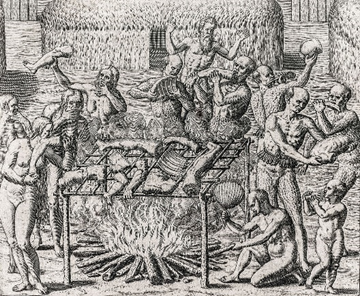
Cannibalism and idolators
Surprisingly, such shocking custom was observed by Marco Polo multiple times: in Fuzhou, China, “They are idolators, belong to the Great Khan, and are under the rule of Fuzhou…they also willingly eat men’s flesh, as long as they have not died a natural death; but those that have been killed by arms they eat completely and consider it to be very good meat.” In an island in Japan, he described that: “when the idolators of this island capture some man who is not their ally…they kill the man they have captured and eat him with his relatives; understand that they cook him: and they hold this human flesh to be the best meat they can have.” Moreover, he was aware of cannibalism in India—in the kingdom of Perlak “I tell you in truth that they eat human flesh and all other flesh—good and bad;” in the kingdom of Samudra “they are savage idolaters…we disembarked from our ships and built castles out of wood and logs, then stayed in those castles for fear of those bestial men who eat men;” in the kingdom of Dagroyan[6] “when he dies, they cook him: then all the dead man’s relatives come and eat him up. I tell you that they also eat all the marrow in the bones[7].” Indeed, there were a great amount of accounts on cannibalism noticed by Marco Polo, but if being scrupulous, we could discover a common point: all people who participated in cannibalism were called “idolators,” the practitioners of idolatry, referring to people who worshipped a physical entity (picture or statue) instead of god. Consequently, under the historical and religious context[8] of Marco Polo, the concept of idolator indicated the people who believed in religions instead of Christian, such as Buddhism and Hinduism, in the countries he travelled. Here came the questions: what was the relationship between the religions of the idolators and cannibalism? Were the descriptions of Marco Polo true, or were they were only guessing of him based on discrepancies in Christian and these religions?
Cannibalism in China
In the first place, the depictions from Marco Polo regarding the cannibalism in Yuan dynasty, China, might be problematic. Back in the thirteenth century, under the leading of Kublai khan, the religion prevailing in China was Buddhism. In the book “the Mongols[9],” the author David Morgan illustrated that the critical role Buddhism played in Yuan dynasty. Morgan claimed that “Kublai accorded his favor, and perhaps his personal allegiance, to one religion above all: to Buddhism.[10]” Originated from Tibet, the neighbor of Yuan dynasty, Tibetan Buddhism[11] blossomed and affected Kublai greatly that he adopted it and practiced it. The most important Buddhist figure was Phags-pa: “His position under Kublai was one of great influence, though how great is in dispute. He was certainly granted the prestigious Chinese title of ti-shih, `imperial preceptor’, and was accorded the headship of the Buddhist church.[12]” This saint propelled the notion of Buddhism and was highly valued by Kublai. As a result, Buddhism was even raised as the national religion in Yuan dynasty. Hence, we could reach a conclusion that by applying the word “idolators” in China, Marco Polo referred to the disciples of Buddhism. Nevertheless, the problem came: Buddhism was a religion strongly against cannibalism. In the article “The Buddhist Core Values And Perspectives For Protection Challenges: Faith And Protection[13]” given by High Commissioner’s Dialogue on Protection Challenges, the author introduced basic beliefs of Buddhism. There were three universal truths, one of them being: ““for every event that occurs, there will follow another event whose existence was caused by the first, and this second event will be pleasant or unpleasant according as its cause was skillful or unskillful.[14]” This law educated people that good is rewarded with good and evil will be requited with evil—it cautioned the believers to accumulate virtue and perform charitable works. Moreover, another major teaching of Buddhism was “no killing respect for life,” that people must not steal or lie, not to mention kill, others[15]. To conclude, behaviors of harming and eating people was harshly forbidden in Buddhism—how could Marco Polo observe these phenomena from the idolators of Buddhism, especially from people around Kublai, an intense adorer of it? There must be some error in the book.
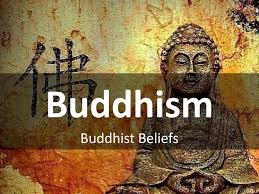
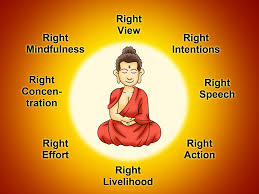
Buddhism Beliefs by Buddha Quotes-issuu/Eight-Fold Pass of Buddha
Cannibalism in Japan
Secondly, Marco Polo’s record of cannibalism on Japan island was dubious. According to him, the people who performed cannibalism were idolators, also the Yuan survivors of the naval war with Japan[16] (the Bun’ei War.) Marco Polo firstly made a mistake on the number of these people—he said there were 30,000 escapees on the island. The book “Kublai Khan’s lost fleet” offered a detailed description of the war: “the fleet that embarked included 23,000 Mongol, Chinese and Korean soldiers and 6,700 sailors under the command of…[17]” Simple calculation told us that there were only 30,000 people in the troop in total, so how could there be 30,000 survivors after the storm[18]? Back to the problem of cannibalism—Kublai Khan’s lost fleet demonstrated that most of the troop consisted of Mongol, Chinese, and Korean soldiers led by Kublai. From the previous paragraph, the Yuan people (no matter Mongols or Chinese), if they were idolators as Marco Polo mentioned, should be worshippers of Buddhism. As for the Koreans, most of them were either Christian or Buddhist. Consequently, the problem emerged from the water—similarly to the condition in China, the survivors of the Bun’ei’s war would not take part in the terrible deeds of consuming their companions, since it was an unforgivable crime in their belief. All in all, the credibility of Marco Polo’s words was again challenged.
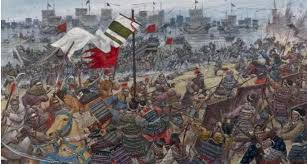
Cannibalism in India
Finally, there was lack of evidence proving that people in the region of India, as Marco Polo depicted, had the custom of cannibalism. The key here was that most people in Indian area, regardless of the kingdom of Perlak, Samudra, or Dagroyan, were reverent believers of Hinduism. Consequently, the “idolator” under Marco Polo’s pen in his description of India was Hinduist—so could there be any connection binding Hinduism and cannibalism? The passage “Hinduism: Basic Beliefs” comprehensively illustrated essential aspects of Hinduism, including its origin, beliefs, practices, and terminologies. The most significant ideology in terms of Hinduism was “incarnation[19],” explained as “to reasonably explain an excess of suffering or of enjoyment in this life, it was assumed that we all have had previous existences, and that we are now reaping the results of those previous actions. It must also be true then that we can take charge of our destiny right now. We can create a better tomorrow by resolving to do better actions today. However, as long as desires remain in the mind, the tendency toward rebirth will exist.[20]” The meaning behind such belief was similar to the “karma[21]” in Buddhism. Hinduist also considered that if one did good in one life, he would be rewarded in the other life. Based on this thought, it was of no reason that idolators would perform the beastly and brutal cannibalism. Marco Polo, thud, was probability telling the wrong story.
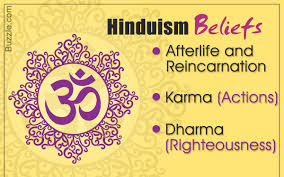
Basic, Core Beliefs on Which the Faith of Hinduism Thrives
Conclusion
Summing up all the above viewpoints, I concluded that, despite Marco Polo offering the audience vivid and picturesque descriptions of cannibalism, they were probably inauthentic and untrustful. Marco Polo probability never went to these places but imagined the scene simply on account of his own comprehension of other religions[22] (other than Christian). Forward speaking, if he fabricated these depictions of cannibalism, I, personally, doubted the credibility of his journey to the east—to what extent was the journey made up? Did he genuinely travel away from his home, or did he just hear these stories from others? Maybe it was still too early to reach a unanimous answer for these queries, but I believed that there must be problems with Marco Polo and his journey.
Footnotes
1.The specific time of his arrival, although not given by Marco Polo in detail, was around 1275.
2.Polo, Marco. The Description of the World. Hackett Publishing Company, Inc.. Kindle version.
3.The Description of the World (para 75, page 63-65)
4.Reflects the Mongolian and Uighur pronunciation (baqshi) of the Chinese boshi, “erudite,” which means knowledgeable people.
5. The Description of the World (para 75, page 65)
6.The specific location of this kingdom is unsure, but probably it refers to the Battak people of northern Sumatra.
7.The Description of the World (page 139, 146-147, 151, 152, 153, respectively)
8.Marco Polo, being a Venetian, was a pious Christian and of course believed in the existence of God. Given the definition of idolatry, the word “idolators” represented the non-Christian people in eastern countries (kingdoms) such as China and India.
9.The Mongols, the second edition. Copyright 1986, 1990, 2007 by David Morgan. Blackwell Publishing.
10. The Mongols (chapter 5, page 123)
11.Also defined as Lamaistic, Tantric Buddhism of Tibet by David Morgan
12.The Mongols (chapter 5, page 124)
13.High Commissioner’s Dialogue on Protection Challenges. Theme: Faith and Protection (12-13 December 2012)
14.This is known as “the law of cause and effect” or “the law of Karma”
15.The five main teachings of Buddhism: No killing Respect for life. No stealing Respect for others’ property. No sexual misconduct Respect for our pure nature. No lying Respect for honesty. No intoxicants Respect for a clear mind.
16.In “the description of the world,” Marco Polo wrote that these escapees looted a Japanese ship and then occupied a city in Japan, expelling the local residence. They held the city for seven months before they surrender. And these Yuan people performed cannibalism on the island.
17.Kubilai Khan’s lost fleet (page 92)
18.The Yuan fleet went through a violent storm on the sea and most soldier died, which cause the defeat of Kubilai.
19.Can be understand as rebirth. Hinduism believes that after people died, they will be reborn in a form or life based on their deeds in the previous life.
20.Hinduism: Basic Beliefs. By United Religions Initiative.
21.Actually, the term “Karma” could also be used in Hinduism since it shared the same thought regarding this concept with Buddhism.
22. This viewpoint is of my own understanding. I guess Marco Polo did not reach these places and wanted to stigmatize their religions, maybe out of his love of his own belief. Again, these are only my assumptions based on my research.
References
Polo, Marco. The Description of the World. Hackett Publishing Company, Inc.. Kindle version.
Morgan, David. The Mongols, the second edition. Copyright 1986, 1990, 2007 Blackwell Publishing.
3. High Commissioner’s Dialogue on Protection Challenges. “The Buddhist Core Values And Perspectives For Protection Challenges” Theme: Faith and Protection. 12-13 December 2012
4. P. Delgado, James. Kublai Khan’s Lost Fleet. Posted on NYU Classes.
5. United Religions Initiative. Hinduism: Basic Beliefs